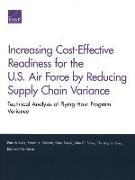- Start
- Increasing Cost-Effective Readiness for the U.S. Air Force by Reducing Supply Chain Variance: Technical Analysis of Flying Hour Program Variance
Increasing Cost-Effective Readiness for the U.S. Air Force by Reducing Supply Chain Variance: Technical Analysis of Flying Hour Program Variance
Angebote / Angebote:
The Air Force spends about $4 billion annually to buy and repair spare parts for aircraft. One way to reduce these costs is to improve the accuracy of demand forecasts: Demand that runs lower than forecast levels results in excess parts, demand that runs higher results in shortages and reduced readiness. One way to improve spare part demand forecasts is to reduce the flying hour variance -- the difference between the number of flying hours that are forecast and the number that are actually flown. RAND researchers were asked to gauge the potential effect of flying hour variance on cost and readiness and identify policy options to rectify problems identified. They determined that although flying hour program variance resulted in a substantial opportunity cost, its effect on enterprise-level financial cost and readiness was relatively small. The Air Force is taking steps to reduce variance in the flying hour program, and researchers endorsed that effort. However, they indicated that other factors had much greater influence and should be dealt with to make significant reductions in the overall variance."--Publisher's description
Fremdlagertitel. Lieferzeit unbestimmt
